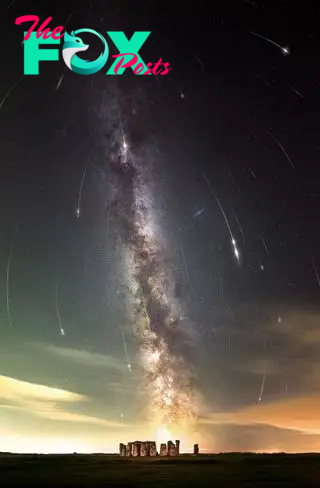Science
Perseid meteor shower rains 'shooting stars' over Stonehenge in glorious astrophotography image
The Perseids, one of the year's most prolific meteor showers, peaked this week, raining dozens of "shooting stars" per hour through Earth's skies.
Some lucky stargazers caught a double feature of meteors and dazzling auroras, which were triggered by a spree of powerful solar eruptions earlier in the week. Others, like U.K.-based astrophotographer Josh Dury, hunted for meteors at thematically appropriate locales — namely, the prehistoric astronomical monument Stonehenge in Wiltshire, England.
Stonehenge, built about 5,000 years ago to align with the sun on the summer solstice, is one of the most popular and intriguing astronomical monuments in the world.
To capture his stunning composite image of Perseid meteors streaking over the famous stones, Dury snapped photos from the monument grounds for three and a half hours. He then combined 43 individual exposures of shooting stars with a deep image of the background sky, where the central band of the Milky Way slashes toward the horizon.
"The Perseids have been a part of my life since I was a youngster at the age of seven-years old when I first began my journey in the world of Astonomy," Dury told Live Science in an email. "For me, they are one of the most magical, anticipating events of the astronomical calendar. Seeing meteors [conjures] images of dreams and it is that mysticism I wished to portray through this image."

Dury's image was taken on the night of Aug. 9, and was featured as NASA's astronomy picture of the day on Aug. 12. If you're interested in capturing the beauty of the night sky, check out our guide to the best astrophotography cameras for beginners and seasoned photographers alike.
Related: Stunning 'parade of planets' image shows 6 worlds aligned over Earth
-

 Science1d ago
Science1d agoInside Capitol Hill’s Latest UFO Hearings
-

 Science1d ago
Science1d agoYou Won’t Want to Miss the Leonid Meteor Shower. Here’s How and When You Can See It
-

 Science2d ago
Science2d agoHere’s What Trump’s Win Means for NASA
-

 Science5d ago
Science5d agoWhy Risky Wildfire Zones Have Been Increasing Around the World
-

 Science6d ago
Science6d agoIt’s Time to Redefine What a Megafire Is in the Climate Change Era
-

 Science1w ago
Science1w ago4 Astronauts Return to Earth After Being Delayed by Boeing’s Capsule Trouble and Hurricane Milton
-

 Science1w ago
Science1w agoThe Elegance and Awkwardness of NASA’s New Moon Suit, Designed by Axiom and Prada
-

 Science1w ago
Science1w agoSpaceX Launches Its Mega Starship Rocket. This Time, Mechanical Arms Catch It at Landing


























